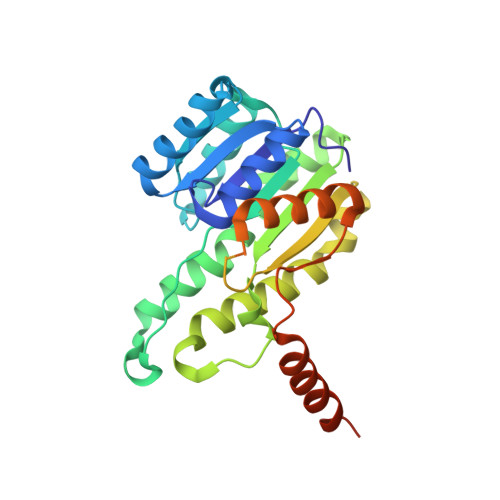Structural and Biochemical Characterization of the Early and Late Enzymes in the Lignin beta-Aryl Ether Cleavage Pathway from Sphingobium sp. SYK-6.
Pereira, J.H., Heins, R.A., Gall, D.L., McAndrew, R.P., Deng, K., Holland, K.C., Donohue, T.J., Noguera, D.R., Simmons, B.A., Sale, K.L., Ralph, J., Adams, P.D.(2016) J Biol Chem 291: 10228-10238
- PubMed: 26940872
- DOI: https://doi.org/10.1074/jbc.M115.700427
- Primary Citation of Related Structures:
4Y98, 4Y9D, 4YA6, 4YAC, 4YAE, 4YAG, 4YAI, 4YAP, 4YAV - PubMed Abstract:
There has been great progress in the development of technology for the conversion of lignocellulosic biomass to sugars and subsequent fermentation to fuels. However, plant lignin remains an untapped source of materials for production of fuels or high value chemicals. Biological cleavage of lignin has been well characterized in fungi, in which enzymes that create free radical intermediates are used to degrade this material. In contrast, a catabolic pathway for the stereospecific cleavage of β-aryl ether units that are found in lignin has been identified in Sphingobium sp. SYK-6 bacteria. β-Aryl ether units are typically abundant in lignin, corresponding to 50-70% of all of the intermonomer linkages. Consequently, a comprehensive understanding of enzymatic β-aryl ether (β-ether) cleavage is important for future efforts to biologically process lignin and its breakdown products. The crystal structures and biochemical characterization of the NAD-dependent dehydrogenases (LigD, LigO, and LigL) and the glutathione-dependent lyase LigG provide new insights into the early and late enzymes in the β-ether degradation pathway. We present detailed information on the cofactor and substrate binding sites and on the catalytic mechanisms of these enzymes, comparing them with other known members of their respective families. Information on the Lig enzymes provides new insight into their catalysis mechanisms and can inform future strategies for using aromatic oligomers derived from plant lignin as a source of valuable aromatic compounds for biofuels and other bioproducts.
Organizational Affiliation:
From the Joint BioEnergy Institute, Emeryville, California 94608, the Molecular Biophysics and Integrated Bioimaging Division, Lawrence Berkeley National Laboratory, Berkeley, California 94720.














